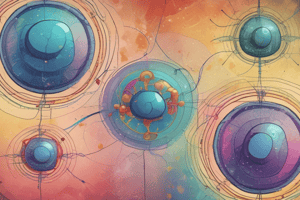Podcast
Questions and Answers
Which of the following accurately describes the process of cytokinesis in animal cells?
Which of the following accurately describes the process of cytokinesis in animal cells?
- Formation of a cell plate
- Separation via binary fission
- Pinching of the cell wall
- Division through cleavage furrow (correct)
What role do vesicles play during cytokinesis in plant cells?
What role do vesicles play during cytokinesis in plant cells?
- They form a cell plate (correct)
- They carry nutrients to daughter cells
- They assist in cleavage furrow formation
- They replicate chromosomes
In what manner do prokaryotes, like bacteria, reproduce?
In what manner do prokaryotes, like bacteria, reproduce?
- Via asexual fragmentation
- By binary fission (correct)
- Through mitosis
- Using budding techniques
Which statement best describes the mechanism of chromosome movement during binary fission?
Which statement best describes the mechanism of chromosome movement during binary fission?
How does the plasma membrane contribute to cytokinesis in bacteria?
How does the plasma membrane contribute to cytokinesis in bacteria?
What is the primary role of kinetochores during prometaphase?
What is the primary role of kinetochores during prometaphase?
During which phase do sister chromatids separate and move toward opposite ends of the cell?
During which phase do sister chromatids separate and move toward opposite ends of the cell?
What mechanism do microtubules use to shorten and facilitate the movement of chromosomes during anaphase?
What mechanism do microtubules use to shorten and facilitate the movement of chromosomes during anaphase?
What is formed at the metaphase plate during metaphase?
What is formed at the metaphase plate during metaphase?
Which process begins during anaphase or telophase, marking the division of the cytoplasm?
Which process begins during anaphase or telophase, marking the division of the cytoplasm?
Flashcards are hidden until you start studying
Study Notes
Cytokinesis in Animal and Plant Cells
- In animal cells, cytokinesis occurs through cleavage, forming a cleavage furrow that separates daughter cells.
- Plant cells undergo cytokinesis by forming a cell plate, which develops into a new cell wall.
Binary Fission in Prokaryotic Cells
- Prokaryotes, including bacteria and archaea, reproduce via binary fission, where a single chromosome replicates starting from the origin of replication.
- After replication, daughter chromosomes move apart as the plasma membrane pinches inwards, dividing the cell into two.
Chromosome Movement During Mitosis
- During prometaphase, spindle microtubules attach to kinetochores, which are protein complexes associated with centromeres of chromosomes.
- At metaphase, chromosomes are aligned at the metaphase plate, the midpoint between the spindle poles.
- Anaphase involves the separation of sister chromatids, which move toward opposite ends of the cell along kinetochore microtubules that shorten by depolymerization.
Spindle Microtubules and Chromosome Dynamics
- Nonkinetochore microtubules from opposite spindle poles overlap and push against one another, elongating the cell.
- Telophase sees the formation of genetically identical daughter nuclei at opposite ends of the dividing cell, while cytokinesis initiates during anaphase or telophase, leading to spindle disassembly.
Eukaryotic Cell Division Overview
- Eukaryotic cell division includes two main processes:
- Mitosis, which divides the genetic material in the nucleus.
- Cytokinesis, which divides the cytoplasm.
- Meiosis, a distinct type of cell division, produces gametes and results in nonidentical daughter cells that have one set of chromosomes (haploid), half the amount of genetic material compared to the parent cell.
Studying That Suits You
Use AI to generate personalized quizzes and flashcards to suit your learning preferences.




